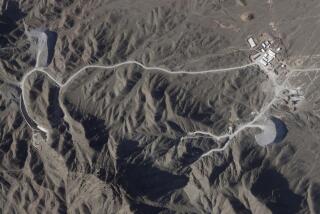Secret Nuclear Rocket Described by Scientists : Space: A foundation says the Pentagon is working on an advanced propulsion system as part of the “Star Wars” anti-missile program.
- Share via
WASHINGTON — The Pentagon is secretly developing a rocket powered by a nuclear reactor and capable of lifting huge weapons and other military payloads into space, a private science foundation said Tuesday.
The advanced nuclear propulsion program, code-named “Timberwind,” has been funded by the Strategic Defense Initiative Organization for several years, according to the Federation of American Scientists, which is based in Washington.
The nuclear powered rocket is years from completion but components are being tested for use in the SDI anti-missile defense program, commonly called “Star Wars.” If the extraordinary rocket is successfully developed, its engines would be far more powerful than any other now in use, thus allowing much bigger and heavier payloads to be launched into space.
But it also would be potentially more dangerous than existing rockets that burn chemical fuels, since an accident could create nuclear fallout.
SDI envisions a test flight that would bring the rocket, propelled by the functioning nuclear reactor, within the Earth’s atmosphere, said Steven Aftergood of the federation.
Such tests would violate a long-standing U.S. government safety standard which dictates that space reactors must not be activated before a space craft has achieved a stable orbit outside the Earth’s atmosphere.
The Soviets for many years have powered dozens of ocean reconnaissance radar satellites with nuclear reactors and several have threatened to re-enter the atmosphere. In fact, in 1978 a Soviet-made Cosmos 954 satellite, powered by a nuclear reactor, re-entered the earth’s atmosphere and disintegrated over northwest Canada, scattering thousands of pieces of debris. Much of the debris was found to have been highly radioactive.
The United States has launched only one reactor into space--in 1965. The reactor aboard the spacecraft operated for 43 days, experienced an electrical shutdown, and remains in high orbit. But 24 other U.S. spacecraft have gone aloft with smaller nuclear power sources, or generators, sparking controversy and concern over safety issues.
Officials of the “Star Wars” program have envisioned using the propulsion system to loft laser weapons into orbit as part of its anti-missile shield, the federation said. However, “Star Wars” planners in recent years have virtually abandoned hope of using the massive laser weapons as part of the shield. Earlier this year, President Bush directed that SDI design a scaled-down version of the anti-missile shield, which would not envision any such weapons.
Thus, it is unclear whether the nuclear powered rocket would be of use to any “Star Wars” plans. The Pentagon has been trying to enlist the National Aeronautics and Space Administration to help fund the program in an attempt to broaden its political base. Aftergood said, however, that NASA already has more than a dozen nuclear propulsion concepts in the research and development stage and he questioned the need for a rocket with a large nuclear reactor that would be tested in the Earth’s atmosphere.
Aftergood said that researchers already have tested the fuel elements for a prototype reactor and studied a proposed suborbital test flight that could pass over the Antarctic and New Zealand.
Pentagon officials could not be reached late Tuesday night and Wednesday morning. SDI officials contacted by the Washington Post Tuesday declined to comment.
A source also reportedly told the Post that reactor development alone is expected to cost $1 billion or more.
More to Read
Sign up for Essential California
The most important California stories and recommendations in your inbox every morning.
You may occasionally receive promotional content from the Los Angeles Times.














